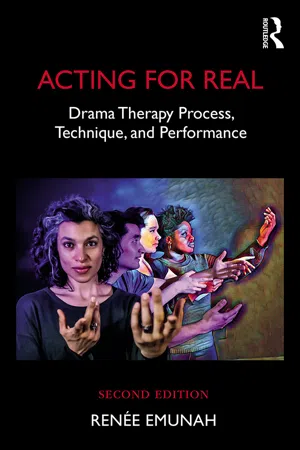
- 356 pages
- English
- ePUB (mobile friendly)
- Available on iOS & Android
About this book
This second edition takes the reader further into the heart of using drama for healing. Dr. Emunah offers an expanded understanding of her Integrative Five Phase model, a foundational approach that embraces the wide spectrum of possibilities within the playing field of drama therapy. Grounded by compassionate clinical examples, including ones that reach over time into deep-seated issues, the book offers tools for action-oriented treatment, embodied therapeutic interventions, and creatively engaging a wide variety of clients.
This comprehensive text also contains over 120 techniques, categorized by phases in the session and treatment series, and subcategorized by therapeutic objective. Process-oriented drama therapy with group and individuals, as well as performance-oriented forms, are described in vivid detail. New to the second edition is an exploration of drama therapy outside of the clinical arena, including dramatic methods in family life and parenting, and drama therapy geared toward social change.
Frequently asked questions
- Essential is ideal for learners and professionals who enjoy exploring a wide range of subjects. Access the Essential Library with 800,000+ trusted titles and best-sellers across business, personal growth, and the humanities. Includes unlimited reading time and Standard Read Aloud voice.
- Complete: Perfect for advanced learners and researchers needing full, unrestricted access. Unlock 1.4M+ books across hundreds of subjects, including academic and specialized titles. The Complete Plan also includes advanced features like Premium Read Aloud and Research Assistant.
Please note we cannot support devices running on iOS 13 and Android 7 or earlier. Learn more about using the app.
Information
PART I
Process
CHAPTER 1
Stages
The Integrative Five Phase Model of Drama Therapy
Introduction
Core Concepts
- The therapeutic journey is eased and strengthened by a sense of gradual unfolding, in which the work is paced and progressive, creating in the clients a sense of security as well as readiness for the next step/level.
- The therapeutic relationship is primary and the work is client-centered. The drama therapist pays close attention to the particular needs and dynamics of individuals and groups, continually fashioning a dynamic process that addresses their uniqueness.
- Beginning the therapeutic process within a creative drama mode is liberating, enabling clients to experience a sense of freedom from the constraints of everyday life and from engrained patterns. The fictional realm is protective, at the same time that it indirectly enables self-expression and revelation. Over time, the need for safeguards diminishes. However, the start points and overall trajectory vary according to the needs and affinities of particular individual and groups, and the model is not dependent on following a linear progression.
- The engagement in the fictional realm circumvents the tendency to immediately rehash predictable, familiar life issues. Over time, the associations clients have between the fictional scenes and their lives lead to a direct working through of real-life issues, but from a fresh, often unexpected perspective. Alternatively, when one begins with real-life issues, later fictional work can expand perspective, repertoire, and options related to personal concerns.
- Intense and complex emotions can be safely expressed in the context of fictional roles, scenarios, and acting processes. Through these processes the drama therapist comes to know the client’s capacity and tolerance for emotional expression and the degree of containment s/he needs, information that is useful in guiding the client and making interventions when the client later engages in highly personal scenes.
- Developing skills, or at least ease, in drama/acting leads the eventual personal scenes to be performed with greater authenticity. The more authentic the enactment, the more deeply the client is affected. A familiarity with dramatic processes also reduces the cognitive distance or disruption that can occur when a client is responding to various drama therapeutic interventions during emotionally delicate scenework in the latter stages.
- The building of trust and interrelationship/s within a group, and/or between drama therapist and client, provides a critical foundation to the later emotional work. The therapeutic value of an individual’s personal scenework is integrally linked to the depth and sensitivity with which other group members—or the drama therapist in individual work—witness, support, empathize with, and thereby help contain that person’s work.
- Techniques used in a session are never isolated, but always interrelated, creating a sense of non-disruptive flow, gradual progression, and aesthetic cohesion.
- Therapeutic work is action-based, including interventions. Dramatically oriented interventions help to develop, deepen, and contain therapeutic work, and even to afterwards “process” what took place.
- The Integrative Five Phase Model is emotionally-based. A central priority is supporting the capacity to identify, express, release, contain, master, “unpack,” transcend, and transform familiar, new, and deep-seated emotions. Emotional expression and containment is built into every phase.
- The Integrative Five Phase Model is relationally-based. There is an ongoing emphasis on building capacity to experience play and self-revelation in the context of a meaningful relationship with the therapist and with others. Processes and interventions in each phase emphasize interconnection.
- The Integrative Five Phase Model is perspective-based. Underlying all phases is an attempt to expand perspective in terms of deepening understanding of others, one’s own multifaceted nature, sociocultural impact on self and other, and one’s relationship to past, present, and future.
The Drama Therapeutic Process
Phase One: Dramatic Play
Table of contents
- Cover
- Half Title
- Title Page
- Copyright Page
- Dedication
- Table of Contents
- Praise for First Edition of Acting for Real
- Acknowledgments
- Prologue
- Introduction
- Part I: Process
- Part II: Techniques
- Part III: Performance
- Part IV: Life
- Epilogue
- References
- Index